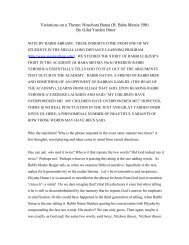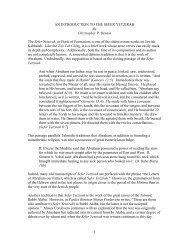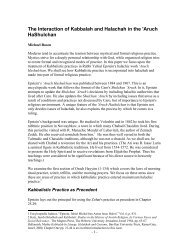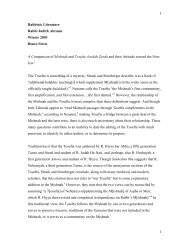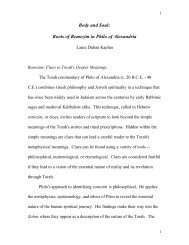The Symbolic Representation of the Sefer Torah - Maqom
The Symbolic Representation of the Sefer Torah - Maqom
The Symbolic Representation of the Sefer Torah - Maqom
Create successful ePaper yourself
Turn your PDF publications into a flip-book with our unique Google optimized e-Paper software.
to <strong>the</strong> synagogue or even touch a holy book. <strong>The</strong> Magen Avraham adds that <strong>the</strong>y were prohibited fromlooking at <strong>the</strong> <strong>Sefer</strong> <strong>Torah</strong>. <strong>The</strong> Turei Zahav (quoting earlier rabbinic sources) clarifies that menstruatingwomen should not look at <strong>the</strong> <strong>Torah</strong> when <strong>the</strong> chazzan displays it to <strong>the</strong> congregants (during hagbahah).To allow women to express <strong>the</strong>ir need to be attached to <strong>the</strong> <strong>Sefer</strong> <strong>Torah</strong>, prior to World War II it wascommon in Europe for <strong>the</strong> women to prepare <strong>the</strong> <strong>Torah</strong>’s sash, or what was popularly called a wimple. 81 Itwas a long usually linen sash used as a binding for <strong>the</strong> <strong>Sefer</strong> <strong>Torah</strong>. In some cases it was made from <strong>the</strong>cloth used to swaddle a baby boy at his circumcision.Hamberger 2000, pp. 332 – 604 <strong>of</strong>fers a lengthy presentation <strong>of</strong> all aspects <strong>of</strong> <strong>the</strong> wimple from <strong>the</strong>time <strong>of</strong> <strong>the</strong> Talmud to <strong>the</strong> present. From <strong>the</strong> period <strong>of</strong> <strong>the</strong> early rabbis women had been involved in itspreparation. It was considered a mitzvah to sew and embroider <strong>the</strong> wimple, even on Saturday night when itwas customary for women not to work. Illiterate woman had <strong>the</strong> men prepare <strong>the</strong> text, and <strong>the</strong>n <strong>the</strong>y wouldembroider over it. In some communities, virgins or brides were sought after to perform this task. O<strong>the</strong>rssaw this deed as a segula (virtue) for barren women. It was most popular for mo<strong>the</strong>rs <strong>of</strong> a new born boy touse <strong>the</strong> cloth from <strong>the</strong> circumcision to prepare <strong>the</strong> wimple. If <strong>the</strong> mo<strong>the</strong>r lacked <strong>the</strong> talent to do <strong>the</strong> work,her immediate female relatives were called upon. In some cases outside pr<strong>of</strong>essional help was sought.<strong>The</strong> wimple was brought to <strong>the</strong> synagogue when <strong>the</strong> circumcised boy reached a certain age. Eachcommunity designated <strong>the</strong> age <strong>the</strong>y thought appropriate. This ceremony usually had little or nothing to dowith <strong>the</strong> mo<strong>the</strong>r, but ra<strong>the</strong>r focused on <strong>the</strong> fa<strong>the</strong>r and son. <strong>The</strong>y would be called to <strong>the</strong> <strong>Torah</strong> to present <strong>the</strong>wimple. If <strong>the</strong> boy was too little to come with <strong>the</strong> fa<strong>the</strong>r (e.g., at <strong>the</strong> age <strong>of</strong> 6 months), <strong>the</strong> mo<strong>the</strong>r wouldbring <strong>the</strong> baby to <strong>the</strong> synagogue (and <strong>the</strong>n give him to his fa<strong>the</strong>r) and at <strong>the</strong> same time while visiting <strong>the</strong>synagogue, <strong>the</strong> mo<strong>the</strong>r would recite <strong>the</strong> customary blessing said after birth. If <strong>the</strong> woman came to pray in<strong>the</strong> woman’s section <strong>the</strong> boy would sit with his mo<strong>the</strong>r until called. After <strong>the</strong> <strong>Torah</strong> reading was completed<strong>the</strong> boy would <strong>the</strong>n return to his mo<strong>the</strong>r. Women would also buy <strong>the</strong> honor <strong>of</strong> folding <strong>the</strong> wimple. <strong>The</strong>rewere a number <strong>of</strong> synagogue functions that were considered women’s tasks and would be auctioned <strong>of</strong>f as<strong>the</strong>ir mitzvah; <strong>the</strong>se included preparing candles, sweeping <strong>the</strong> synagogue and folding <strong>the</strong> wimple. In some81 A Yiddish word from <strong>the</strong> German “cloth.” In old German it meant to cover up.35



